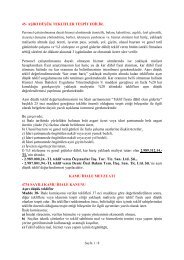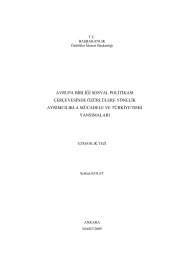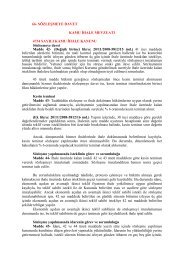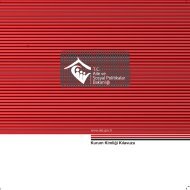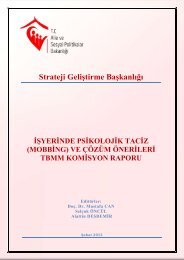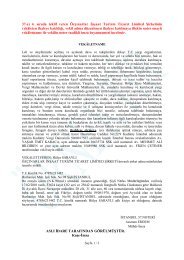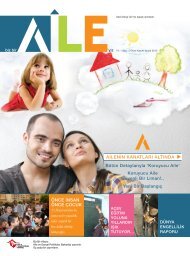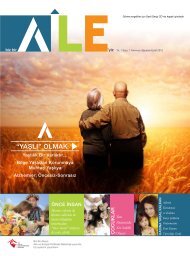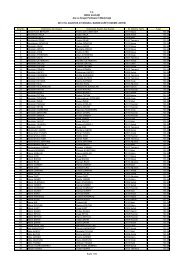Sosyal PolÄ°tÄ°ka tÄ°ka - EÄitim ve Yayın Dairesi BaÅkanlıÄı - Aile ve ...
Sosyal PolÄ°tÄ°ka tÄ°ka - EÄitim ve Yayın Dairesi BaÅkanlıÄı - Aile ve ...
Sosyal PolÄ°tÄ°ka tÄ°ka - EÄitim ve Yayın Dairesi BaÅkanlıÄı - Aile ve ...
- No tags were found...
You also want an ePaper? Increase the reach of your titles
YUMPU automatically turns print PDFs into web optimized ePapers that Google loves.
A CRITICAL ASSESSMENT ON THE CONDITIONAL CASH TRANSFER PROGRAMME<br />
IN THE CONTEXT OF GENDERED POVERTY IN TURKEY<br />
Mehmet Ali KÜÇÜKÇAVUŞ<br />
same grade more than once to maintain their beneficiary status. CCT education benefits<br />
are paid for a period of time that starts with enrolment to primary school and<br />
ends with high school graduation.<br />
CCT health benefits aim to reach the pre-school children who aged between zero and<br />
six or pregnant women, in the poorest six percent of the population, as in CCT education<br />
component. To maintain beneficiary status for CCT health benefits, children<br />
should be brought to regular check-ups monthly, bi-monthly or semi-annually depending<br />
on their age. Similar conditions are applied for pregnant women. In addition<br />
to these regular checks-up conditions and CCT health benefits, an extra cash benefit<br />
is paid to each beneficiary woman to pre<strong>ve</strong>nt the risks of pregnancy on the condition<br />
that deli<strong>ve</strong>ry and post-treatments must be realized in hospitals and post-pregnancy<br />
follow-ups must be fulfilled regularly (SYDGM, 2011b).<br />
Since the CCT programme in Turkey was designed particularly to increase school<br />
enrolment and attendance rate of girls and strengthen position of mothers in poor<br />
and disadvantageous families, payments for both CCT education and health benefits<br />
are usually made to mothers. Similarly, the amount of benefits or stipends is higher<br />
for the girls than boys. According to GDSAS data, number of CCT beneficiaries, as of<br />
September 2010, was 3.002.214 and 2.103.589.781-TL, equivalent to 1,5 billion US<br />
dollars was transferred to the CCT beneficiaries since the beginning of programme in<br />
2003 (Esenyel and Torun, 2010, p.13).<br />
GDSA uses impact assessment studies to evaluate the impacts of its social assistance<br />
and po<strong>ve</strong>rty reduction programmes. Therefore, a quantitati<strong>ve</strong> and two qualitati<strong>ve</strong><br />
studies were materialized by the International Food Policy Research Institute (IFPRI)<br />
in 2006 and 2007 in order to assess and analyze the impact of the CCT programme.<br />
An additional final report on impact assessment of the CCT programme was also<br />
prepared by IFPRI for GDSAS in 2007. These studies represented highly interesting<br />
findings and assessments on impacts of CCT programme and different factors that<br />
affects the programme.<br />
These findings of impact assessment studies will be discussed in details so as to re<strong>ve</strong>al<br />
contributions of CCT programme to mitigate devastating of effect of gender po<strong>ve</strong>rty<br />
or gendered nature of po<strong>ve</strong>rty o<strong>ve</strong>r women in Turkey. It seems more practical methodologically<br />
to align the findings of these studies from specific ones to general ones.<br />
Hence, findings of impact assessment studies on the CCT education benefits will be<br />
assessed firstly.<br />
These impact assessment studies examined CCT education benefits depending on<br />
various aspects, including operational performance, targeting efficiency at national<br />
and community le<strong>ve</strong>ls, impact of CCT education benefits o<strong>ve</strong>r education sector, the<br />
role of the programme as complementary support for education, local understanding<br />
57



